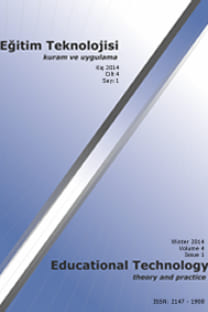BÖTE NEDİR? NASIL TANIMLANIR? OKUL MÜZESİYLE BAŞLAYAN SERÜVENDEN İNSAN PERFORMANS TEKNOLOJİLERİNE UZANAN YOLCULUK
Bu mektupta Bilgisayar ve Öğretim Teknolojileri Eğitimi Bölümü (BÖTE)'nü tanıtmak,alandaki kavramları ve bu kavramlar arasındaki ilişkiler açıklanmaya çalışılmıştır. Bu amaçlaöncelikle alandaki temel kavramlar olan eğitim ve öğretim teknolojisi kavramlarınıntanımlarına yer verilmiştir. Ayrıca alanın temel bileşenleri olan teknolojilerine, öğrenmeyaklaşımlarının alana etkilerine ve öğretim sistemleri geliştirme kavramlarına dadeğinilmiştir. Çalışmada son olarak eğitim teknolojilerinden doğan ancak daha sonra onu dakapsayan performans teknolojileri hakkında bilgi verilmiş ve bir BÖTE mezunun kendinehangi alanlarda yer bulabileceği kısaca açıklanmaya çalışılmıştır.
WHAT IS CEIT? HOW TO DEFINE IT? THE JOURNEY STARTING FROM SCHOOL MUSEUMS TO HUMAN PERFORMANCE TECHNOLOGIES
This letter is an attempt to introduce the department of Computer Education andInstructional Technology (CEIT) and to describe the concepts in the field and relationsamong them. To this end, educational and instructional technology, basic concepts in thefield, were explained initially. Technologies which are fundamental constituents of the field,influential relations of the learning approaches to the field and instructional systemsdevelopment were elaborated. Finally, information concerning performance technologies,originated from educational technologies and later covered all, were given and jobopportunities for a graduate of CEIT were briefly discussed.
___
- Alessi, S. M., ve Trollip, S. R. (2001). Multimedia for learning methods and development (3rd ed.). Boston, Massachusetts: Allyn & Bacon.
- Driscoll, M. P. (2005a). Radical behaviorism. In Psychology of learning for instruction (3rd ed.) (pp. 29-69). Boston, MA: Allyn & Bacon.
- Driscoll, M. P. (2005b). Cognitive information processing. In Psychology of learning for instruction (3rd ed.) (pp. 71-110). Boston, MA: Allyn & Bacon.
- Driscoll, M. P. (2005c). Constructivism. In Psychology of learning for instruction (3rd ed.) (pp. 384-410). Boston, MA: Allyn & Bacon.
- Driscoll, M. P. (2007). Psychological foundations of instructional design. In R. A. Reiser (Ed.), Trends and issues in instructional design and technology (2nd ed.) (pp. 36-44). Upper Saddle River, NJ: Pearson Education, Inc.
- Duffy, T. M., ve Cunningham, D. J. (1996). Constructivism: Implications for the Design and Delivery of Instruction. In David H. Jonassen (Ed.). Handbook of Research for Educational Communications and Technology. New York: Macmillan.
- Ertmer, P. A., ve Newby, T. J. (1993). Behaviorism, cognitivism, constructivism: Comparing critical features from an instructional design perspective. Performance Improvement Quarterly, 6(4), 50-72.
- Gagne, R.M., Wager, W.W., Golas, K.G., ve Keller, J.M. (2005). Principles of instructional design. Toronto, ON: Thomson Wadsworth.
- Januszewski, A., ve Persichitte, K. A. (2008). A history of the AECT's definitions of educational technology. In A. Januszewski& M. Molenda (Eds.), Educational technology (pp. 259-282). New York: Lawrence Erlbaum Associates.
- Jonassen, D. H. (1990). Toward a constructivist view of instructional design. Educational Technology, 30(10), 32-34.
- Molenda, M., Pershing, J.A., ve Reigeluth, C.M. (1996). Designing instructional systems. In Robert Craig (Ed.), The ASTD Training and Development Handbook, 4th ed. New York: McGraw-Hill.
- Morrison, G. R., Ross, S. M., ve Kemp J. E. (2004). Designing effective instruction(4th ed.). Hoboken, NJ: John Wiley & Sons.
- Pershing, J. (2006). Human performance technology fundamentals. In J. A. Pershing (Ed.) (2006), Handbook of human performance technology (3rd ed.) (pp. 5-34). San Francisco: Pfeiffer.
- Reigeluth, C. M. (1999). What is instructional design theory and how is it changing? In C. M. Reigeluth (ed.), Instructional-design theories and models volume II: A new paradigm of instructional theory, (pp. 1-29). Mahwah, NJ: Lawrence Erlbaum Associates.
- Reiser, R. A. (2001). A history of instructional design and technology: Part II: A history of instructional design. Educational Technology Research and Development, 49(2), 57-67.
- Reiser, R. A. (2007). What field did you say you were in? Defining and naming our field. In Trends and issues in instructional design and technology (2nd ed.) (pp. 2-9). Upper Saddle River, NJ: Pearson Education, Inc.
- Saettler, P. (1990). Behaviorism and educational technology. In The evolution of American educational technology (pp. 286-317). Englewood, CO: Libraries Unlimited.
- Seels, B.B., ve Richey, R.C. (1994). Instructional technology: The definition and domains of the field. Washington, D.C. Association for Educational Communications and Technology.
- Silber, K. H., ve Foshay, W. R. (2006). Designing instructional strategies: A cognitive perspective. In J. A. Pershing (Ed.), Handbook of human performance technology (3rd ed.) (370-413). San Francisco: Pfeiffer.
- Van Tiem, D. M., Mosely, J. L., ve Dessinger, J. C. (2004). Performance technology - defined. In Fundamentals of performance technology. (pp. 2-20). Washington, DC: International Society for Performance Improvement.on, 35(1), 30-35.
- Wilmoth, F. S., Prigmore, C., ve Bray, M. (2010). HPT models In R. Watkins & D. Leigh (Eds.), Handbook of improving performance in the workplace, vol. 2: Selecting and implementing performance interventions (pp. 5-26). Silver Spring, MD: International Soceity for Performance Improvement.
- ISSN: 2147-1908
- Yayın Aralığı: Yılda 2 Sayı
- Başlangıç: 2011
- Yayıncı: Tolga Güyer
Sayıdaki Diğer Makaleler
Hasan ÇAKIR, Ayça ÇEBİ, Seher ÖZCAN
OKUL YÖNETİCİLERİNİN TEKNOLOJİK LİDERLİK ÖZ-YETERLİLİKLERİ
Şükrü ADA, Rıdvan KÜÇÜKALİ, Deniz GÖRGÜLÜ
Hemşirelerin Uzaktan Eğitime İlişkin Görüşleri
Hasan ÇAKIR, Ayça ÇEBİ, Seher ÖZCAN
ÖĞRETİM ELEMANLARININ ÖĞRETİM AMAÇLI İNTERNET KULLANIMINA DAİR GÖRÜŞLERİ
Mohammed Q. MUSTAFA, Sami ŞAHİN
Mustafa İLHAN, Servet DEMİR, Seyfettin ARSLAN
Okul Yöneticilerinin Teknolojik Liderlik Öz Yeterlilikleri
